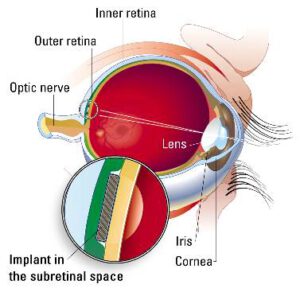Home » News and Events » The Artificial Retina Brings Hope to Those Blinded by AMD
The Artificial Retina Brings Hope to Those Blinded by AMD
Posted by: Florida Eye Microsurgical Institute in 2013-06 Issue

There’s been much in the news recently about the artificial retina, and with good reason. The ‘bionic eye,’ as many have come to call it, has enabled some patients, blinded by retinitis pigmentosa, to see shapes, light and some objects.

The degenerative eye condition strikes around one in 5,000 people worldwide, but it’s possible the Argus II (recently FDA approved for use) and other artificial retinas in development could work for those with age-related macular degeneration, which affects one in 2,000 people in developed countries.
Florida Eye’s retinal/vitreous/macular degeneration specialist, Dr. Randy Katz says that the research for artificial retinas has been going on for years, and he can understand why those having the device implanted are thrilled with the results, however, “the artificial retina still has a long way to go – many years, in fact – before it can really be thought of as a bionic eye. What the Argus II device does,” adds Dr. Katz, “is give users more mobility, because they can see shapes, light, doorways and such, and that helps them navigate better.”
But those doorways, lights and shapes are like works of art for those who have not seen anything for much of their adult lives. “Without the system, I wouldn’t be able to see anything at all, and if you were in front of me and you moved left and right, I’m not going to realize any of this,” said Elias Konstantopolous, in a recent New York Times article. The 74-year-old retired electrician in Baltimore was one of about 50 Americans and Europeans who have been using the device in clinical trials. Konstantopolous said it (the device) helps him differentiate curbs from roads, and detect contours of objects and people. “When you have nothing, this is something. It’s a lot.”
To read more about the studies, the recipients and who is eligible for the device, here are some articles worth reading, including one from MIT Technology Reviewand another from Web MD.
And when you have a few moments, these two videos are fascinating because they feature the same woman, a test recipient, and you can see the progress she has made in the two years since the device was implanted. We’ve already featured these two videos on our site, but if you haven’t seen them, they are well worth watching.
